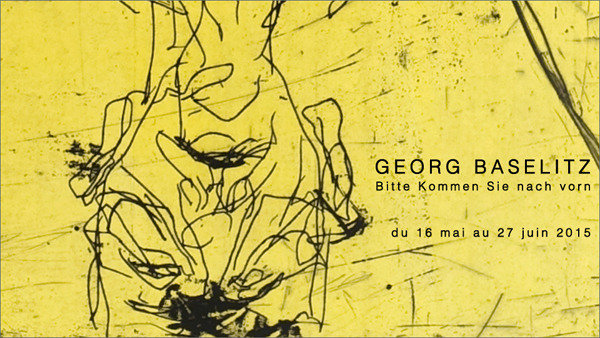Georg Baselitz
dal 15/5/2015 al 26/6/2015
Segnalato da
15/5/2015
Georg Baselitz
Galerie Catherine Putman, Paris
Bitte kommen Sie nach vorn. Dating from 2013 until 2015, these works are all self-portraits or self-representations, like the series of monumental paintings that theartist presents at the 56th Venise Biennial.

At the occasion of edition of new engravings of Georg Baselitz, the Gallery Catherine Putman presents the exhibition of the artist’s prints and inks on paper.
Dating from 2013 until 2015, these works are all self-portraits or self-representations, like the series of monumental paintings that the German artist presents currently at the 56th Venise Biennial at the exhibition All the World’s Futures, of which the curator is Okwui Enwezorest. Painter, sculptor, engraver, Georg Baselitz regularly practices the engraving since the beginning of the 1960s. He is considered today as one of the greatest engravers among the painters of his generation. He attacks the copper, the wood or linoleum plates with as much violence and mastery as that found in his paintings and sculptures.
BittekommenSienachvorn (Please move forward), 2014 is the title of four etchings, edited by the Gallery, self-portraits of the artist, naked and upside down. The feet float in the upper side of the image, the tip of the head — at the bottom — is truncated, the staid character of this figure, crossed out with two vertical lines in a form of a cross and inscribed in the narrow format of a plate, half-opens disturbed, distracted.
On the same theme, the Gallery presents Farewell Bill, 2013, a black and white portfolio of ten engravings, nine of which are the self-portraits of Georg Baselitz wearing a cap on which can be found an inscription “Zero”. A view of the figure of the artist: Zero fur den maler (Zero for the artist), is sometimes titled with irony and ambiguity. On certain plates of this portfolio, Georg Baselitz is at the limit of figuration, he blurs the figure, making it almost disappear with expressive power.
The self-portrait in painting, in sculpture or in engraving, is recurring in the work of Georg Baselitz since 1959. The practice of this classic genre, beyond the possible introspection that it suggests, is characterized in the recent works by great freedom in the treatment of intimacy and of the relationship to the body.
Two engravings on paper, untitled from 2015, complete the exhibition, the painter representing himself always naked, upside down and from the back. The position of legs suggests that he is in motion, walking, with washes of black ink.
Hans Georg Kern was born on the 23rd January 1938 in Deutschbaselitz in Saxe, close to Dresde. In 1961 he takes on the name of Baselitz, borrowed from his home village. He lives and works in Munich. From the very beginning, his work expresses reactions on traumas and tragedies closely linked with the history of Germany. Since the 1960s, the works of Baselitz have been a subject of numerous individual and collective international exhibitions. Georg Baselitz represents Germany in 1980 at the Venise Biennial, is present at documenta 5,6,7, in 1972,1977 and 1982 in Kassel. The Museum Solomon R Guggenheim in New York presents the first retrospective of engravings in 1995, exhibited afterwards at Angeles County Museum, at Hirshhorn Museum in Washington D.C., at Nationalgalerie in Berlin and Musée d’Art Moderne de la Ville de Paris. The Royal Academy of Art in London organises another significant retrospective in 2007. From September 2011 until June 2012, Musée d’Art Moderne de la Ville de Paris displays a retrospective of his sculptured work, followed in 2013 by a vast retrospective at the occasion of the 75th birthday of the artist, at the Essl Museum in Vienna.
Image: invitation
Press Contact: contact@catherineputman.com
Opening on Saturday 16th May, 3 - 7 pm
Galerie Catherine Putman
40 rue Quincampoix
Paris



